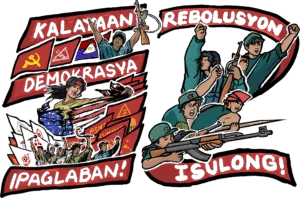6. Perseverance and development of the Communist Party of the Philippines
By virtue of its own history and circumstances, the Communist Party of the Philippines could be reestablished in 1968 and could resume the revolutionary armed struggle in 1969. A series of major Right and "Left" opportunist errors had afflicted the old merger party of the Communist and Socialist parties and needed to be rectified in the light of Marxism-Leninism-Mao Zedong Thought.
The Right opportunist line of reducing the units of the people's army to small teams of three to five members and refraining from tactical offensives from 1942 to 1943 and welcoming the return of the US from 1943 to 1945 limited the development of the people's army in the course of World War II and subsequently derailed the revolutionary mass movement towards legalism from 1946 to 1948. It shifted to "Left" opportunism when the party decided in 1948 to wage armed struggle and win in two year's time, without developing the people's army in stages, implementing land reform and carrying out painstaking mass work. After the arrest of the principal cadres in 1950, Right opportunism came back with a vengeance and continued until the reestablishment of the Communist Party of the Philippines in 1968.
The CPP was among the parties least expected to succeed in people's war, supposedly because the Philippines was an archipelagic country, without the advantage of having a common land border with China. That is not the only disadvantage. The Philippines is the favorite secure base from which US imperialism launches all kinds of intervention and military aggression in Asia. The ruling classes of big comprador and landlords are well schooled and trained in counterrevolution. Moreover, the US-Marcos regime imposed a 14-year long fascist dictatorship on the people. But it failed to destroy the CPP and the revolutionary movement. Instead, these grew from small to big and from weak to strong.
The CPP has proven that under correct leadership it can preserve and develop the people's army and other revolutionary forces, such as the organs of political power and the mass organizations. It has generated powerful mass movements in the economic, social, political and cultural fields for the benefit of the people along the line of national democratic revolution. The people's army has been waging people's war for more than 38 years, far longer than it took China to win the people's democratic revolution. The CPP has learned much from the teachings of Comrade Mao about protracted people's war and has successfully applied these on the concrete conditions of the Philippines.
But there are those who might say that the people's war has been extremely protracted in the Philippines. If this is said to demoralize the people and the revolutionary forces, the riposte is: how much more successful at social revolution or basic reforms are those who have engaged mainly or solely in legal and electoral struggle or those who have been wishing for a quick victory in armed struggle?
The CPP has accumulated enough revolutionary experience and knowledge to respond to the challenge of accelerating the advance of the people's democratic revolution. In this connection, it must study well and analyze the concrete conditions of the Philippines. At the same time, it must consider how people's war can resurge in Southeast Asia and in other global regions under the present crisis conditions of the world capitalist system.

